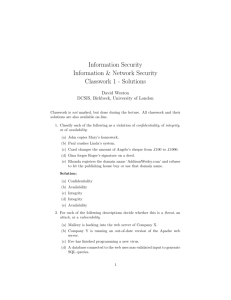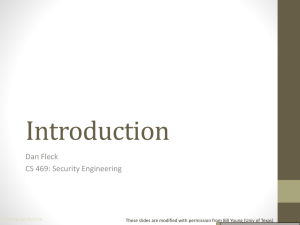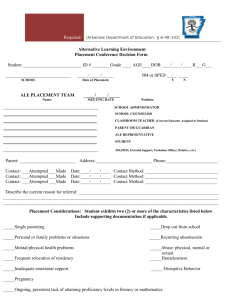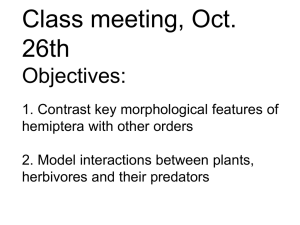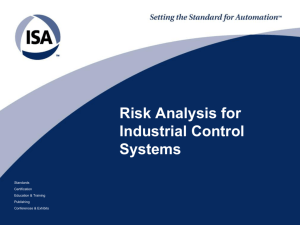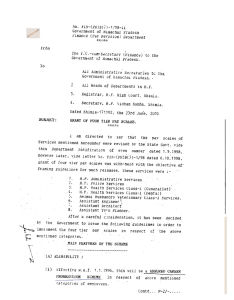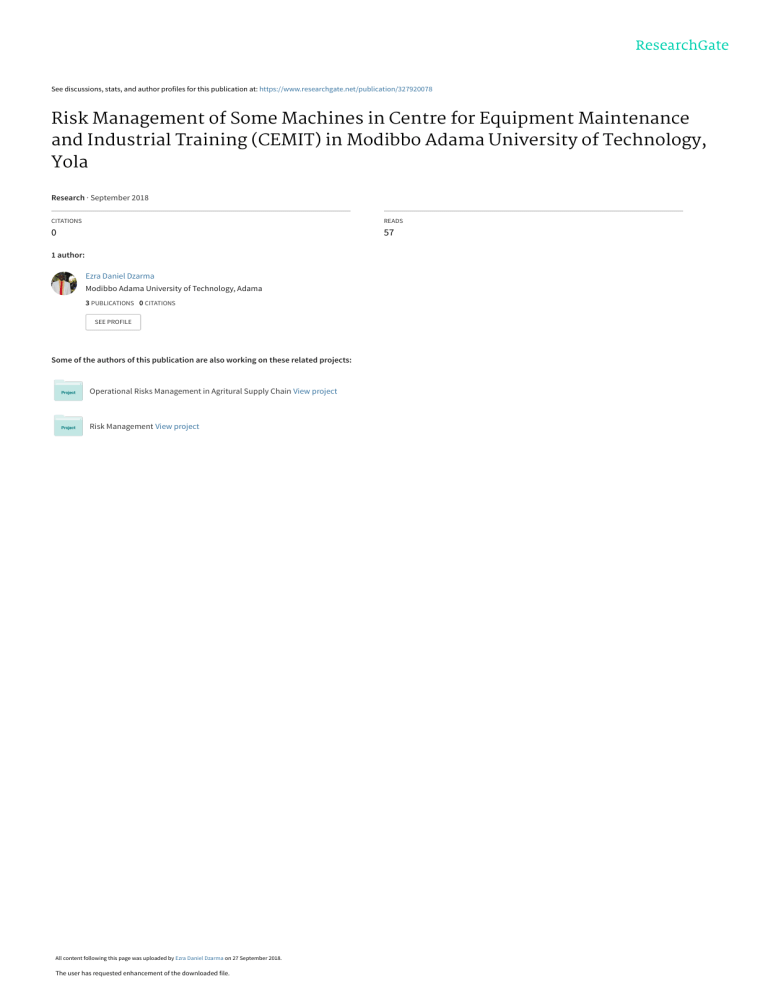
See discussions, stats, and author profiles for this publication at: https://www.researchgate.net/publication/327920078 Risk Management of Some Machines in Centre for Equipment Maintenance and Industrial Training (CEMIT) in Modibbo Adama University of Technology, Yola Research · September 2018 CITATIONS READS 0 57 1 author: Ezra Daniel Dzarma Modibbo Adama University of Technology, Adama 3 PUBLICATIONS 0 CITATIONS SEE PROFILE Some of the authors of this publication are also working on these related projects: Operational Risks Management in Agritural Supply Chain View project Risk Management View project All content following this page was uploaded by Ezra Daniel Dzarma on 27 September 2018. The user has requested enhancement of the downloaded file. International Journal of Science and Research (IJSR) ISSN (Online): 2319-7064 Index Copernicus Value (2013): 6.14 | Impact Factor (2013): 4.438 Risk Management of Some Machines in Centre for Equipment Maintenance and Industrial Training (CEMIT) in Modibbo Adama University of Technology, Yola Dzarma, Daniel Ezra1, S.S. Abdulkadir2, Idama3, E.A 1, 2 Department of Statistics and Operations Research, ModibboAdama University of Technology, Yola, Nigeria 3 Chemical Engineering Department, ModibboAdama University of Technology, Yola, Nigeria Abstract: Centre for Equipment Maintenance and Industrial Training (CEMIT) in ModibboAdama University of Technology, Yola faces some risks associated with machines operations. The following method was used to address the problems: Structured questionnaire was used to obtained data on financial losses from CEMIT. The Annualized Loss Expectancy Model (ALEM) was employed to analyse the data. The analysis of the data obtained reveals that the tenoning machine has highest ALE of₦800,000, next to it is circular saw machine which has The Annualized Loss Expectancy ALE of ₦559,980, Spindle moulding machine which has ALE of ₦329,985 is third and mortising machine with ALE 0f ₦25,000 is the least. The management were recommended to allocate resources for the maintenance of the machine in the order of their ALE priority. The assets with highest ALE should be allocated higher resources likewise with the subsequent assets. Keywords: Risk, management, Annual Loss, and machines 1. Introduction This research is focused toward addressing the problems of risk associated with some equipment in Centre for Equipment Maintenance and Industrial Training (CEMIT) in ModibboAdama University of Technology, Yola. This will be achieved by identifying the machines with high risks and develop strategies for risk mitigation.Proper management of equipment assets affects production costs. When maintenance can be performed knowledgeably and only when needed, costs can be reduced. As efforts to maximize and optimize the process have occurred, additional stress on the mechanical assets may have been introduced, resulting in higher support costs. In some cases, the increased asset support costs may exceed the additional process benefits. Clearly, the impacts need to be known and understoodHarker (2000). There are different dentitions of risk but the most famous definition of risk is that provided by Knight (1921), who wrote during a period of active research into the foundations of probability. Contemporaneous research includes John Maynard Keynes (1921), Misses (1928), and Kolmogorov (1933). One debate from this period relates to subjective versus objective interpretations of probability. According to objective interpretations, probabilities are real. We may discover them by logic or estimate them through statistical analyses. According to subjective interpretations, probabilities are human beliefs. They are not intrinsic to nature. Individuals specify them to characterize their own uncertainty. The philosophical roots of subjective interpretations of probability may be traced to Hume (1748): Though there be no such thing as Chance in the world; our ignorance of the real cause of any event has the same Paper ID: SUB15213 influence on the understanding, and begets a like species of belief or opinion. (p. 55) Groundbreaking accounts of subjective probability include those of Ramsey (1931), Finetti (1937), and Savage (1954). The subjectivist position is aptly summarized by de Finetti The abandonment of superstitious beliefs about the existence of Phlogiston, the Cosmic Ether, Absolute Space and Time, or Fairies and Witches, was an essential step along the road to scientific thinking. Probability, too, if regarded as something endowed with some kind of objective existence, is no less a misleading misconception, an illusory attempt to exteriorize or materialize our true probabilistic beliefs (Holton, 2004). Risk management is a permanent cycle process that involves activities for establishing, monitoring and ensuring continual improvement of the organization’s activity. This process includes four main activities, which have to be permanent applied and developed: - Design the management system involves identifying business requirements, assessing the likelihood and the impact of the risks, including the implementation of a security policy and selecting the adequate countermeasures for the existing risks; • Implement the management system involves applying control measures and work procedures, resource allocation, setting the responsibilities and conduct training and awareness programs; • Monitoring, reviewing and reassessing the management system involve an evaluation of effectiveness of controls and working procedures, of business changes, of previous incident reports and of existent risks; • The improvement and update of the management system involves correcting the identified dysfunctions, or eliminating the unsustainable decisions or applying new control measures. Volume 4 Issue 1, January 2015 www.ijsr.net Licensed Under Creative Commons Attribution CC BY 917 International Journal of Science and Research (IJSR) ISSN (Online): 2319-7064 Index Copernicus Value (2013): 6.14 | Impact Factor (2013): 4.438 ( Dzarma, 2014). Risk management is a systematic approach for minimizing exposure to potential losses. It provides a disciplined environment for continuously assessing what could go wrong (i.e., assessing risks) determining which risks to address (i.e., setting mitigation priorities) implementing actions to address high-priority risks and bring those risks within tolerance The three core risk management activities: Assess risk—transform the concerns people have into distinct, tangible risks that are explicitly documented and analyzed Plan for risk mitigation—determine an approach for addressing or mitigating each risk; produce a plan for implementing the approach Mitigate risk—deal with each risk by implementing its defined mitigation plan and tracking the plan to completion. These three activities form the foundation of the Risk Management Framework (Alberts and Audrey 2010). The risk management process involves several steps—all designed to help reduce uncertainty concerning the occurrence of a loss. The process consists of six steps: risk identification, risk quantification and evaluation, risk avoidance, loss prevention and control, risk financing, and re-evaluation. Risk Identification: The first step in the risk management process is to determine the risks of loss to which the library is subject. This will involve an analysis of the operations of the library and identification of risks inherent in those operations. In this step, the library will identify those assets or operations that, if damaged or destroyed, would cause difficulty to ongoing operations. Risk Quantification and Evaluation The next step in the process is to quantify the risks identified in step one. This involves an evaluation of the potential size of losses that may occur from the different risks identified and the likelihood that such losses will occur. In other words, the library will evaluate the probable frequency and severity of losses from various risks. Risk Avoidance Avoidance can be the most effective risk management strategy but for many risks inherent in the library’s operations, it may not be practical or even possible in the context of the library’s mission of service to its community. Yet, some risks can be avoided without causing disruption to library operations. It is advisable to eliminate risks wherever possible and feasible. Loss Prevention and Control Many risks of loss either can be eliminated or reduced significantly by loss prevention activities. Risk Financing: Ultimately, many risks will remain both part of the library’s operations and its financial responsibility. Therefore, risk financing is a major component of the risk management process. Risk financing is the process of selecting the most cost-effective means of ensuring funds will be available after a loss to allow the library to rebuild and restore damaged or destroyed property and to continue its mission of service to its constituents. Paper ID: SUB15213 Transferring the Risk to Others Whenever possible, risks should be transferred from the library to others with whom it does business via a noninsurance transfer, such as “hold harmless” or indemnity clauses in contracts with third parties. An indemnity clause or hold harmless agreement written into a contract or lease agreement will provide that a third party contracting with the library will accept financial responsibility for losses caused by that third party’s negligent operations on behalf of the library (Breighner and Payton, 2005). 2. Methodology The Annualized Loss Expectancy (ALE) used in this paper to assess risk is in lined with the one used by Danjuma and Dzarma (2014) for Threat Analysis of Some Information Security Assets. Annualized Loss Expectancy (ALE) (SLE) was computed as the product of Exposure Factor (EF) and the Asset Value Before the threat (AVB). Mathematically 𝑆𝑆𝑆𝑆𝑆𝑆 = 𝐸𝐸𝐸𝐸 × 𝐴𝐴𝐴𝐴𝐴𝐴 Step 2 (EF) was computed as the difference between the Asset Value Before threat (AVB) and Asset Value After the threat (AVA) divided by the Asset Value Before the threat multiply by 100 𝐸𝐸𝐸𝐸 = 𝐴𝐴𝐴𝐴𝐴𝐴 − 𝐴𝐴𝐴𝐴𝐴𝐴 . 100 𝐴𝐴𝐴𝐴𝐴𝐴 Step 3 Annualized Rate of Occurrence (ARO) was computed as the ratio of Number of the Times (NT) the threat occurs and the Number of Years Observed (NYO). 𝑁𝑁𝑁𝑁 𝐴𝐴𝐴𝐴𝐴𝐴 = 𝑁𝑁𝑁𝑁𝑁𝑁 Step 4 Annualized Loss Expectancy (ALE) was computed as the product of Single Loss Expectancy and Annual Rate of Occurrence: 𝐴𝐴𝐴𝐴𝐴𝐴 = 𝑆𝑆𝑆𝑆𝑆𝑆 × 𝐴𝐴𝐴𝐴𝐴𝐴 Analysis and Result Annualized loss expectancy of computer, books and the library building Table below gives the summary of ranking ALE of the spindle moulding machine, Tenoning machine, mortising machine and Circular saw. Table 1: ALE Spindle moulding machine AVB AVA EF ARO ₦1,500,000 ₦400,000 73.33% 3/10 The data in table 1 were used to compute the ALE of Spindle moulding machine which is given in table 5 Volume 4 Issue 1, January 2015 www.ijsr.net Licensed Under Creative Commons Attribution CC BY 918 International Journal of Science and Research (IJSR) ISSN (Online): 2319-7064 Index Copernicus Value (2013): 6.14 | Impact Factor (2013): 4.438 Table 2: ALE Tenoning machine ₦5,000,000 ₦1,000,000 80% 2/10 AVB AVA EF ARO The data in table 2 were used to compute the ALE Tenoning machine as given in table 5 Table 3: ALE mortising machine AVB AVA Depreciation /EF ARO ₦100,000 ₦50,000 50% 5/10 most of these older machines is not very high. This is because of the way the machine operates and the type of work done, both of which make conventional guarding difficult. This machine has high chance of injuring operators (http://www.hse.gov.uk).This indicates that tenoning machine has the highest risk among the four machines.the results also shows that circular saw has second annualized loss expectancy which also indicates that it has high risk .Spindle moulding machine andMortising machine have moderate and low risk respectively. 4. Recommendations The data in table 3 were used to compute the ALE of mortising machinewhich is given in table 5 The management of CEMIT are recommend to allocates resources for machine maintenance and replacements in ALE Prority as follows: Table 4: ALE Circular saw Tenoning machine should be given first priority, next to it is circular saw, followed by spindle moulding machine and mortising machine is last. AVB AVA EF ARO ₦3,000,000 ₦200,000 93.33% 2/10 The data in table 4 were used to compute the ALE of mortising machine this is given in table 5 Table 5: The annual Loss Expectancy (ALE) summary for some Library Assets Asset AVB EF SLE ARO ALE spindle ₦1,500,000 73.33 ₦1,099,950 0.3 ₦329,985 moulding % machine Tenoning ₦5,000,000 80 % ₦4,000,000 0.2 ₦800,000 machine mortising ₦100,000 50% ₦50,000 0.5 ₦25,000 machine Circular ₦3,000,000 93.33% ₦2,799,900 0.2 ₦559,980 saw The information in the table 5 shows that Tenoning machine has highest Asset Value Before the threat (₦5,000,000),next to it is Circular saw (₦3,000,0000) followed bySpindle moulding machine (₦1,500,000) and mortising machine (₦100,000) is last. Circular saw have highest Exposure factor (93.33%), followed by Tenoning machine (80%), next to it is spindle moulding machine (73.33%) and mortising Machine (50%) is last. Circular saw has the highest Single Loss Expectancy of ₦2,799,900 next to it is Tenoning machine ₦4,000,000 followed by spindle moulding machine (₦1,099,950) and mortising machine(₦50,000) is last. Mortising machine have highest Annual Rate of Occurrence (ARO) of 0.5, next to it is spindle moulding machine (0.3), followed bycircular saw and tenoning machine (0.2). Tenoning machine has highest Annualized Loss Expectancy of ₦800,000, Circular saw has moderate ALE of₦559,980next is spindle moulding machine ₦329,985 and mortising machine has least ALE of ₦25,000. 3. Discussion The results in the table 5 shows tenoning machine has highest Annualized Loss Expectancy. There are currently a large number of the traditional hand-fed, single-end toning machines still in operation and the standard of guarding at Paper ID: SUB15213 References [1] Alberts, C. J and Audrey J. Dorofee, A. J (2010).Risk management framework. Acquisition Support Program, Technical Report, August 2010 http://www.sei.cmu.edu [2] Breighner, M. and Payton, W. (2005). Risk and Insurance Management Manual. Library Administration & Management Association,a division of ALA. http://www.alastore.ala.org. [3] Danjuma, J. and Dzarma, E. (2014).Threat Analysis of Some Information Security Assets inIbrahim Babangida Library of ModibboAdama University of Technology, Yola. Unpublished manuscript [4] Dzarma, E.D (2014), Library Security Risk Analysis: case study of ModibboAdama University of Technology ,Yola. Masters Thesis submitted to the department of Statistics and operations. [5] Harker R. (2000).Understanding Machinery Management – Using Machine Condition and Process Information for Maximum Benefit.ORBIT Third Quarter 2000 [6] Hume, D. (1748). Enquiry Concerning Human Understanding. Keynes, John Maynard. 1921. A Treatise on Probability. London: Macmillan. [7] Holton, G. A. (2004). Defining Risk. Financial Analysts Journal Volume 60, Number 6 [8] Finetti, B. (1937). “La Prévision: Ses Lois Logiques, SesSources Subjectives.” Annales de l’Institut Henri Poincaré, vol. 7: 1–68. Translated (1964) in Studies in Subjective Probability. [9] Knight, F. H. (1921).Risk, Uncertainty, and Profit. New York: Hart, Schaffner, and Marx. [10] Kolmogorov, A. N. (1933) .Grundbegrif f e der Wahrscheinlichkeitsrechnung. Berlin: Springer-Verlag. Translated [11] (1960) as Foundations of the Theory of Probability. 2nd English ed. [12] New York: Chelsea Publishing. Ramsey, F. P. (1931). “Truth and Probability.”The Foundations of Mathematics and Other Logical Essays. New York: Harcourt Brace. Volume 4 Issue 1, January 2015 www.ijsr.net Licensed Under Creative Commons Attribution CC BY 919 International Journal of Science and Research (IJSR) ISSN (Online): 2319-7064 Index Copernicus Value (2013): 6.14 | Impact Factor (2013): 4.438 [13] Knight, F. H. (1921).Risk, Uncertainty, and Profit. New York: Hart, Schaffner, and Marx. [14] Kolmogorov, A. N. (1933) .Grundbegrif f e der Wahrscheinlichkeitsrechnung. Berlin: Springer-Verlag. Translated [15] (1960) as Foundations of the Theory of Probability. 2nd English ed. New York: Chelsea Publishing. [16] Mises, R. (1928). Wahrscheinlichkeit, Statistik und Wahrheit. [17] 3rd German ed. Translated (1957) as Probability, Statistics and Truth. 2nd revised English ed. New York: Macmillan. [18] Savage, L. J. (1954). The Foundations of Statistics. New York: John Wiley & Sons. [19] Safe use of single-end tenoning machines ;Woodworking Sheet No 39 http://www.hse.gov.uk Paper ID: SUB15213 View publication stats Volume 4 Issue 1, January 2015 www.ijsr.net Licensed Under Creative Commons Attribution CC BY 920
